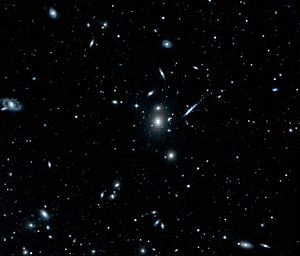Leo cluster of galaxies
| Leo cluster of galaxies | |
|---|---|

|
|
| Abell 1367 with NGC 3842 in the center of the picture | |
| Constellation | Leo |
|
Position Epoch : J2000.0 Equinox : J2000.0 |
|
| Right ascension | 11 h 44.61 m |
| declination | + 19 ° 45.53 ′ 0 ″ |
| Appearance | |
| Brightest member | NGC 3842 |
| Physical data | |
| Redshift | 0.0276 |
| distance | about 110 Mpc |
| Catalog names | |
| Abell 1367, RXC J1144.6 + 1945 | |
The Leo galaxy cluster or Leo cluster , listed in the Abell catalog as Abell 1367 , is a galaxy cluster located in the constellation Leo . (It should not be confused with the Leo I group or the Leo triplet .)
The Leo galaxy cluster together with the Coma galaxy cluster form the two most important members of the Coma supercluster . The distance information ranges between 110 and 120 MPc .
The brightest galaxy in this cluster is NGC 3842 , within a radius of 1 ° there are 166 other galaxies whose redshifts only differ by ± 10% from the redshift of NGC 3842, which is a clear indication of a common group membership. The mean redshift of 0.0276 suggests a radial escape speed of 8274 km / s. The larger members are NGC 3842, NGC 3883 , NGC 3884 , NGC 3861A and B , NGC 3837 , UGC 6697 , NGC 3862 , NGC 3864 . In total, the Leo Galaxy Cluster comprises over 500 galaxies.
The Leo cluster lies at the intersection of two large filaments that connect the cluster to the Virgo cluster in the southeast and the Coma cluster to the northeast. The high proportion of spiral galaxies , the low concentration of galaxies in the center and the irregular structure of the X-rays suggest a dynamically young system. A detailed spatial and dynamic analysis of the member galaxies shows a clear non-Gaussian distribution of the velocities, the cluster is stretched in the southeast-northwest direction with two density maxima and associated substructures, whereby the temperature of the NW sub-cluster is above the temperature of the SE sub-cluster and these two substructures seem to be on the way of union.
Individual evidence
- ↑ a b c d e f NASA / IPAC Extragalactic Database Abell 1367 (RXC J1144.7 + 1949)
- ↑ a b SIMBAD Abell 1367
- ↑ Michael König, Stefan Binnewies: Bildatlas der Galaxien , Franckh-Kosmos -Verlag 2019, ISBN 3-4401-6274-5
- ↑ Abell 1367 - The Leo Galaxy Cluster, beskeen.com
- ^ L. Cortese, G. Gavazzi, A. Boselli, J. Iglesias-Paramo, L. Carrasco: Multiple merging in the Abell cluster 1367 . In: Astronomy & Astrophysics . 425, No. 2, October 2004, pp. 429-441. doi : 10.1051 / 0004-6361: 20040381 .

